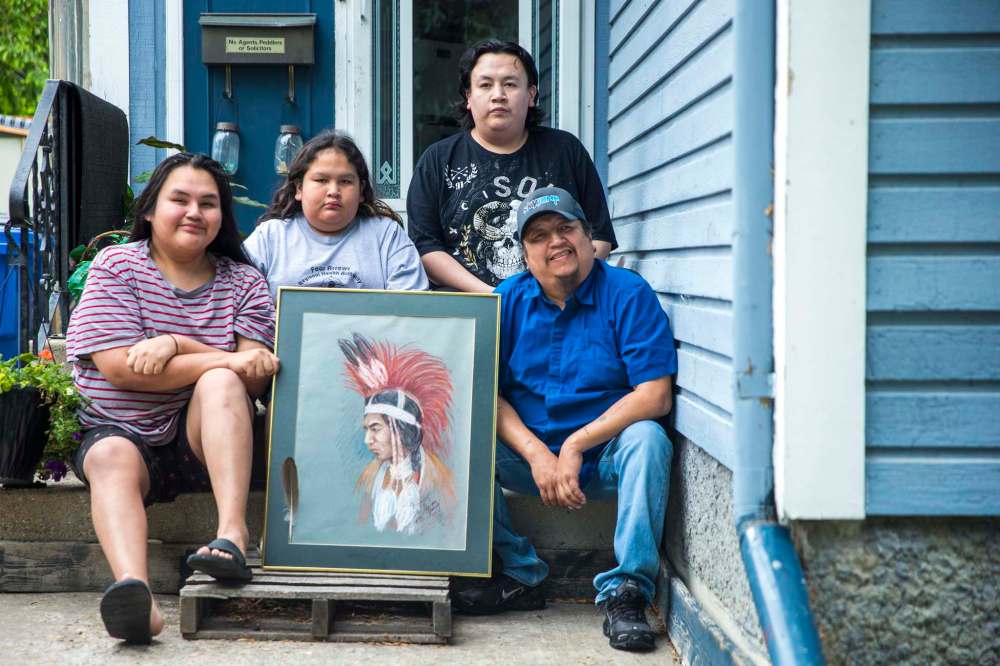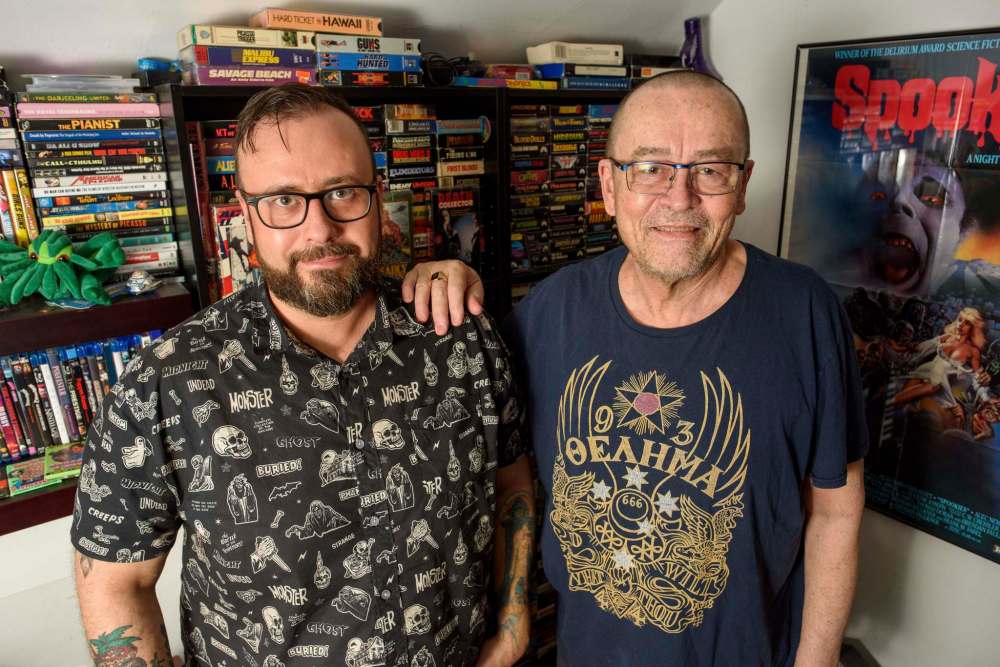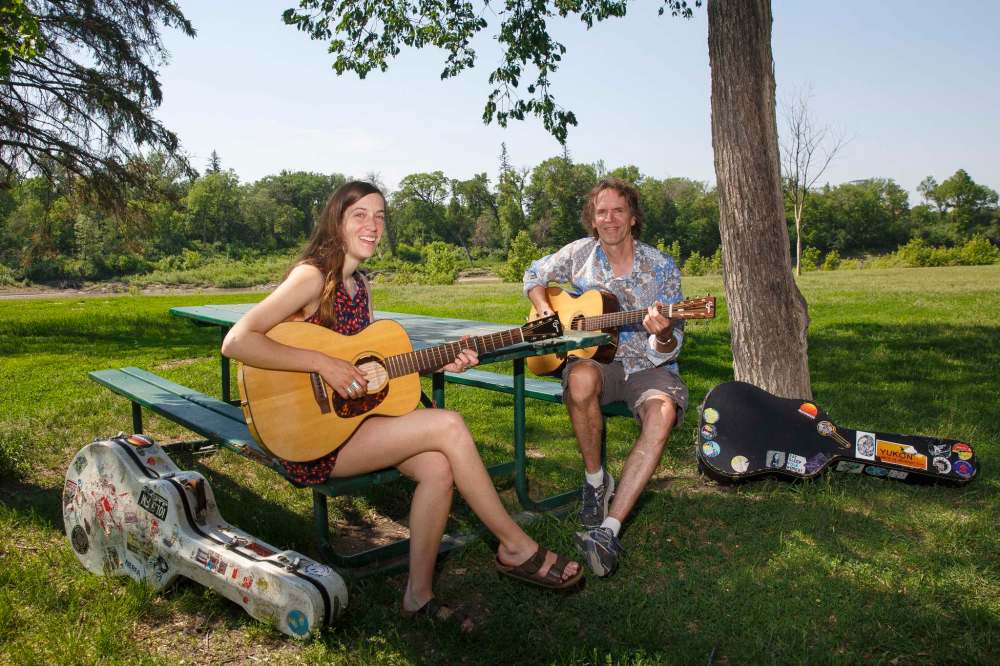Here’s to you, dad Fathers play powerful role inspiring growth in children
Read this article for free:
or
Already have an account? Log in here »
To continue reading, please subscribe:
Monthly Digital Subscription
$0 for the first 4 weeks*
- Enjoy unlimited reading on winnipegfreepress.com
- Read the E-Edition, our digital replica newspaper
- Access News Break, our award-winning app
- Play interactive puzzles
*No charge for 4 weeks then price increases to the regular rate of $19.00 plus GST every four weeks. Offer available to new and qualified returning subscribers only. Cancel any time.
Monthly Digital Subscription
$4.75/week*
- Enjoy unlimited reading on winnipegfreepress.com
- Read the E-Edition, our digital replica newspaper
- Access News Break, our award-winning app
- Play interactive puzzles
*Billed as $19 plus GST every four weeks. Cancel any time.
To continue reading, please subscribe:
Add Free Press access to your Brandon Sun subscription for only an additional
$1 for the first 4 weeks*
*Your next subscription payment will increase by $1.00 and you will be charged $16.99 plus GST for four weeks. After four weeks, your payment will increase to $23.99 plus GST every four weeks.
Read unlimited articles for free today:
or
Already have an account? Log in here »
Hey there, time traveller!
This article was published 19/06/2020 (2004 days ago), so information in it may no longer be current.
Look critically at the institution of Father’s Day and there is potential for a certain negative undercurrent.
After all, not everything passed from father to child is benign. A business or a vocation may be passed from generation to generation, but so are prejudices, resentments and blind spots.
But at their best, fathers, like anyone, can represent the best of humanity: creativity, tolerance and an adventurous spirit.
With that in mind on this Father’s Day weekend, consider these father-child pairings as a reason to celebrate the day.
Byron and Jackson Beardy

When Byron Beardy was young, he was, rather to his frustration, never referred to as Byron.
“I was always introduced as ‘This is Jackson’s son,’” he says with a laugh.
Beardy’s father, you see, is the famed Anishinew artist Jackson Beardy, who was a prominent member of the Indigenous Group of Seven and whose Woodlands-style works continue to influence contemporary Indigenous art.
Byron, now 50, was just 14 when his father died of complications from a heart attack. His parents separated when he was younger, and he was raised in Wasagamack mostly by his mother. “I was back and forth, and I felt I was never settled,” he recalls. But his visits with his father left an indelible impression.
“I knew of my father’s work and his travelling quite a bit, and whenever we met, it was always while he was travelling and doing his work,” Byron recalls. “That intrigued me, I think, to go to places where he’d gone. That opened my eyes that way, and to do things beyond, what I called at an early age, the ‘hidden wall.’ When I was younger, I thought that the majority of our people couldn’t see past those community lines. I was fortunate enough to have been back and forth, between the urban setting, the contemporary setting, and back home, the traditional setting, at an early age. I had my vision to go beyond the confines of the community walls, if you will.
“What my father instilled in me was to know who you are and where you come from, and to never forget that, but to still go out and explore and meet new people.”
With an aptitude for art himself, Byron was often told to follow in his father’s footsteps, a path that took him to the University of Manitoba’s fine arts department. But a fateful critique in second year made him re-evaluate that trajectory.
“What my father instilled in me was to know who you are and where you come from, and to never forget that, but to still go out and explore and meet new people.”– Byron Beardy
“A piece of my work was being critiqued in class, with the prof, and the prof said, ‘You know, your dad used to do it like this,’” he recalls. “I was like, ‘Wait, I’m not Jackson. I’m not trying to be.’ And that killed it. I didn’t go back. I wanted to be me, Byron Beardy.”
Byron went into computer programming instead, but he embraced another artistic gift: music. He made his public debut at 12 — “I remember my knees were shaking beyond belief” — and he still performs today, everything from gospel and traditional to country and Christian music, everywhere from bars and socials to sweat lodges.
Now, Byron is a father of two daughters, Vanna and CJ, and three sons, Jackson Beardy III (Byron is Byron Jackson Beardy II), Jayden and Jimmie. “All of them are musically and artistically inclined,” he says. (Byron and his wife are also currently taking care of their five grandchildren.)
Jackson III found success as a hoop dancer, and Byron accompanied his son on vocals and drums. “(Hoop dancing) became a father-and-son bond that I didn’t have,” Byron says.
Jackson III started hoop dancing at four. “He started learning — and it wasn’t just about the tricks or designs with the hoops, it was actually having to go into ceremony, had to get his name, had to get his colours, had to get the right to use these hoops as teaching tools,” Byron says.
Hoop dancing took the pair to events, ceremonies and festivals in every city across the country, as well as across the Atlantic. In 2013, the pair were invited to perform at Buckingham Palace as part of the 250th anniversary of the Royal Proclamation.
Jackson III hasn’t been dancing much these days owing to an ankle injury. Still, “it was an awesome ride,” Byron says. “I still get phone calls for him.”
In 2017, Byron got to reconnect with his own dad via a Manitoba Museum project called Spirit Lines, which was developed to re-introduce oral histories to the communities of Norway House Cree Nation and Garden Hill First Nation.
In addition to being an artist, Jackson Beardy was also a collector of oral histories. “He went to the community and interviewed Elders who are now gone. And then they were referring to interviews from the early 1900s. My father wrote the interviews in English,” Byron explains.
The Manitoba Museum wanted Jackson’s texts in their original Anihshininiimowin. “So I had the honour of translating them back.”
— Jen Zoratti
Jaimz and C. Graham Asmundson

“The story I always like to tell,” says visual artist C. Graham Asmundson of the birth of his son Jaimz, “is that I picked him up when he was four minutes old. And he stared right into my eyes and clenched his fists and shook them at me.
“He still has that attitude with me,” Graham says with a laugh.
If the relationship is occasionally rocky, it’s also tight. Graham, 67, is an accomplished visual artist, but also a seasoned arts administrator, having worked at art institutions ranging from the Manitoba Arts Council to the Plug In Institute of Contemporary Art, where, until recently, he had served as grant officer for the past 11 years.
Jaimz, 39, also works in the realm of arts administration as the programming director of Cinematheque, and also pursues his art, mainly as a filmmaker, but also more recently as a musician, working alongside his wife, Karen Asmundson, on a “dark synthpop” band called Ghost Twin.
“That started as something for us to do together as a hobby and it became a lot more than that very quickly,” says Jaimz.
Jaimz’s state of marital harmony contrasts with his parents’ relationship. Graham separated from Jaimz’s late mom, poet Carol Barton, when Jaimz was about six.
“We jointly parented,” Graham recalls. “Things weren’t always easy, but it worked out and I think Jaimz got the best of both worlds from both his parents.
“His mom was an extremely intelligent person and quite dynamic and vivacious,” Graham says of Barton, who died in 2011.
It was a defining moment in their relationship when Graham came out as gay to Jaimz when the boy was just seven years old, an event Jaimz recounted to animator Alain Delannoy for his 2016 animated short film The Talk.
“I don’t think I ever had a sex talk from my parents, but I do remember having the coming-out conversation quite vividly,” says Jaimz, recalling the time he won a role in a Video Pool film and attended the première in the West Broadway Community Centre with his mom. Graham showed up just before the screening was to commence.
“I remembered you weren’t there and I was quite upset that you weren’t there,” Jaimz says to Graham. “And then you came in at the last minute with a friend.
“And I don’t even remember seeing the film, I just remember staring at my dad and his friend,” Jaimz recalls. “I’m trying to process the emotions I was feeling and then I realized, ‘Oh, he’s gay.’
“And I thought about that all night and I was crying and then I thought about it and asked, ‘Why am I crying?’ I didn’t really understand what it meant to be gay because I was seven years old.
“So the next morning, (he) came over and said, ‘I want to have a talk with you.’ And I said, ‘You want to tell me that you’re gay.’ And he said, ‘Well, do you know what that means? And I said, ‘Not really, no.’
“I gave a pretty graphic physical description of how it worked,” says Graham.
If Jaimz was still confused, things crystallized for him in the larger culture. This was around the time CBC was airing the sketch comedy show The Kids in the Hall.
“I remember coming home and my mom had the news on and there was a documentary special on CBC. Scott Thompson had just come out and they were interviewing him about why he decided to do it and how important it is for him to be able to do that.
“When that happened, all my friends who are also really into Kids in the Hall were like, ‘Wow, Scott Thompson is hilarious and he’s awesome.’ So I think that opened everyone to the fact that gay people are people too.
“It created the opportunity for me to tell them that my dad is gay and I love my dad. It just reinforced what they had already known,” Jaimz says. “It was just normal. And it created a lot of dialogue as well.”
“It was a really great time, honestly.”
Jaimz’s embrace of his father ultimately exposed him to many of the gay artists in the community who enriched Jaimz’s own art and life, Graham says.
“There was never any stigma,” Graham says. “James just got this huge extended community of adult friends who were all artists and dynamic and interested in what he was doing.
“I don’t think it was ever a struggle for Jaimz,” Graham says. “It was really kind of a plus. It gave him a huge, vibrant life and community that he wouldn’t have otherwise had.”
— Randall King
Madeleine Roger and Lloyd Peterson

Father’s Day isn’t a big deal for Madeleine Roger.
“Wait, it’s Father’s Day?” jokes the 28-year-old singer-songwriter.
The joke undoubtedly comes from a place of love and respect that Roger shares with her father and inspiration, Lloyd Peterson. She also shares his talent for music.
“I started off as a singer-songwriter in a band called the Cheer in the late ‘80s” says Peterson, 61. “After that band ended, I was a radio producer for a while and then I moved in to studio ownership and producing and engineering music.”
Peterson currently owns Paintbox Recordings, which is where Roger recorded her folk-roots albums Fairweather (with her twin brother Lucas under the name Roger Roger in 2016) and Cottonwood in 2018 as a solo artist under her full name, after her brother opted to pursue a career in building and repairing guitars instead of performing.
“He was more keen to spend time in his wood shop than out on tour,” says Roger, who plays on a guitar that her brother built (as does her dad).
Surprisingly, even though she grew up in a musical family, Roger didn’t always want to pursue music as a career.
“I sort of felt like music was my dad’s thing. I actually started off being really interested in musical theatre.”– Madeleine Roger
“I sort of felt like music was my dad’s thing,” she says. “I actually started off being really interested in musical theatre.”
She was so passionate about it that she pursued a degree in theatre and film at the University of Winnipeg, but when she learned to play guitar in her second year, her focus shifted.
“I really fell in love with it right away and became enamored with songwriting,” she says. “You might say I stopped paying attention to my studies. I just got really, really focused on songwriting.”
The shift didn’t come as a shock to her dad, though.
“Madeleine was always heavily exposed to it even when she wasn’t pursuing it,” Peterson says. “When the kids were little, our family went to folk festival every year.”
Peterson also enjoyed having his kids tag along at work in the recording studio.
“I’d often end up in the control room, absorbing whatever all these other bands were creating,” Roger says. “I was often curious about what my dad was up to, especially in the mixing process of the album. I’d often just hang out in the studio either being totally silent and trying to learn what I could or also pipe up and ask questions, maybe a little too often sometimes.”
“Never,” says Peterson. “I always loved having the kids around whenever there was an opportunity. Ever since they were born, they were a part of all the musical things going on around.”
But the close-knit family admit that they have no Father’s Day plans.
“We don’t often make a big fuss because we know how we feel about each other,” Peterson says.
Instead, they share their feelings through activities they both enjoy, like camping.
“Every summer, we would always do a road trip and go camping and often canoeing,” says Roger. “I think that’s going to be a forever love that we share.”
What both are truly looking forward to is spending more time with family when the pandemic settles down.
“Madeleine’s got two grandmothers who are living on their own and it’s going to be so great to be able to spend more time together.”
— Frances Koncan
Nicole Bent and Bo Wohlers

It was a circuitous path that brought Nicole Bent to become a co-owner of Shelmerdine Garden Centre, part of a company her father, Bo Wohlers, helped bring to prominence in the Winnipeg area.
Sure, she had worked in the garden centre as a summer job while growing up, but she went on to study interior design — not horticulture — at the University of Manitoba.
Afterward, she worked with Palliser Furniture’s subsidiary, EQ3. She enjoyed design, but she says the work environment didn’t suit her.
“I found out I didn’t belong in a big corporate setting,” Bent says.
It was about the same time when Wohlers started thinking about Shelmerdine’s future. He says when he turned 60 — that was 14 years ago — told his family “now was the proper time” to consider getting into the business, if they were interested.
Bent listened to her father’s proposal and returned to the Roblin Boulevard garden centre just beyond Winnipeg’s city limits after leaving Palliser. She gave the concept some thought. A little fatherly advice didn’t hurt either.
“He told me to go work with trees and shrubs until you get your head right. (Eventually) I saw the gift shop wasn’t performing as it should, and I thought (from) my experience with Palliser, I could do better.”– Nicole Bent, recalling her father’s advice
“He told me to go work with trees and shrubs until you get your head right,” Bent recalls. “(Eventually) I saw the gift shop wasn’t performing as it should, and I thought (from) my experience with Palliser, I could do better.”
Wohlers would go on to split Shelmerdine into two divisions. He continues to head its landscaping side — he came to Canada from Germany with a landscape engineering degree and a passion for plants and trees; he became one of the partners at Shelmerdine in 1974 — while Bent and Chad Labbe, who became a Shelmerdine co-owner in 2010, run the garden-centre division.
It’s turned out to be a good fit. Bent and Labbe have expanded Shelmerdine’s retail side to the point that the gift shop sells clothing, decor and furniture as well as pots, plants and trees. Bent’s interior design knowledge has helped spruce up the garden centre, which proved useful this spring when Shelmerdine, like other garden centres and all retail outlets, had to adapt interior spaces to match the province’s social-distancing protocols brought on by the COVID-19 pandemic.
When Wohlers compares the garden centre to what it was, a father’s pride shows.
“I have some creativity for plants, but if you look at Shelmerdine now, she’s taken it to a higher level,” Wohlers says. “She’s created one of the top garden centres in North America.”
Bent says she’s learned plenty about business and how to treat customers from her father, but she admits her knowledge of flowers, trees and shrubs doesn’t come close to Wohlers’ horticultural and landscaping expertise he’s picked up in his lifetime.
“To be honest, I don’t have a big green thumb,” Bent says. “I’ve learned my share but I’m not an expert. When I go on Dorothy Dobbie’s radio show (The Gardener on CJNU) I get really nervous.
“But (Shelmerdine) is more than just plants.”
— Alan Small

In a way, Randall King was born into the entertainment beat.

Frances Koncan (she/her) is a writer, theatre director, and failed musician of mixed Anishinaabe and Slovene descent. Originally from Couchiching First Nation, she is now based in Treaty 1 Territory right here in Winnipeg, Manitoba.

Alan Small has been a journalist at the Free Press for more than 22 years in a variety of roles, the latest being a reporter in the Arts and Life section.

Jen Zoratti is a Winnipeg Free Press columnist and author of the newsletter, NEXT, a weekly look towards a post-pandemic future.
Our newsroom depends on a growing audience of readers to power our journalism. If you are not a paid reader, please consider becoming a subscriber.
Our newsroom depends on its audience of readers to power our journalism. Thank you for your support.





